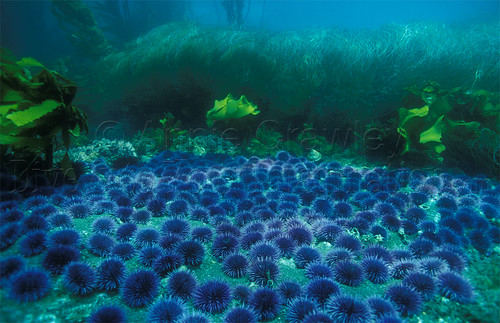 |
Image by Annie Crawley
|
But the truth is, no matter how adorable or fuzzy, useful and/or cute an animal may be, TOO many of them is nothing but trouble! True for Star Trek tribbles and for sea urchins!
(disclaimer: Tribbles are science fiction, sea urchins are not)
*Tribble factoid: Someone has ACTUALLY given tribbles a scientific name: Polygeminus grex! don't believe me? go see Memory Alpha!)
Tribbles are actually a GREAT introduction for today's topic: SEA URCHIN BARRENS!
What are Sea Urchin Barrens?? These are places where a sea urchin species' abundance increases dramatically to the point where the urchin devours EVERYTHING in its path, effectively leaving all else 'barren' except for more hungry sea urchins.
 |
| Image by Annie Crawley |
This is not far removed from the imagined "ecology" of Star Trek's tribbles (A good essay applying real population math about tribble populations can be found here, but this image from the famous ST:TOS episode hopefully gives you the general idea!)
 |
| Image from TrekNews.net |
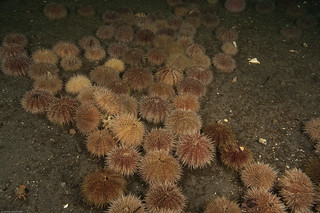 |
| Image by AndyOlsson |
What causes urchin barrens?
Um. Its complicated but the common thread seems to be that there is an association between barrens and the absence of sea urchin predators.
In many of the papers I've read about Northern Hemisphere species, the loss of a major sea urchin predator seems to be one of the immediate attributed causes of the runaway population growth, but as we've seen with other species such as the Crown of Thorns (Acanthaster planci) the story is often complicated....
Most of the studies involve temperate-cold water urchins in the Strongylocentrotidae, specifically Strongylocentrotus purpuratus (purple urchin), S. franciscanus (red urchin), S. droebachiensis (green urchin) and S. polyacanthus. Literature was abundant, but this paper by Nathan Stewart & Brenda Konar provided much of (but not all) the info for this post.
In one of the most familiar studies from the Pacific Northwest coast, the main predators were sea otters (in many cases, I assume Enhydra lutris-some papers did not mention species).
The fundamental ideas outline the notion that as sea otter populations decline, predation pressure decreases and with nothing to keep the populations at a controlled level sea urchin populations dramatically increase and began to devour kelp (and really everything else!) to the extent that they effectively clear the bottom.
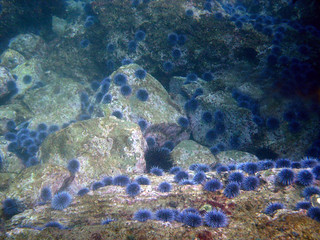 |
| Image by Santa Monica Bay Restoration Foundation |
 |
| Image by Annie Crawley |
- Urchin densities were SEVEN times greater than those elsewhere
- Kelp forest (vs. 'barren') urchins were larger and more robust
- "Barren' urchins were smaller with less tissue
- "Barren urchins had little to no reproductive tissue compared to kelp forest urchins
On the North Atlantic coast, there is a similar population explosion of the Green Urchin, Strongylocentrotus droebachiensis, which from the look of it, is pretty severe
Here's a video that shows just WOW... a lot of them..
I have briefly written about the impact of this many Green Sea Urchins. They all POOP! This actually has a pretty serious ecological impact.
Some, such as this paper, have proposed that these population increases have been caused by the loss of lobsters (Homarus americanus) which feed on green sea urchins. But in all liklihood, as the system is better understood the more complicated the explanation.
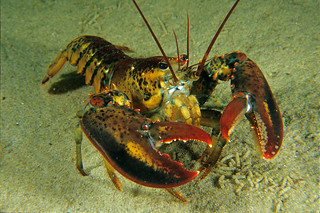 |
| Image by AJmart |
Now, in the Southern Hemisphere we have a similar, parallel situation with a completely different family and species of sea urchin: Centrostephanus rodgersii (Diadematidae).
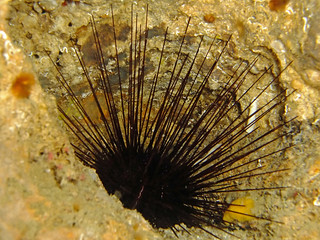 |
| Image byEdward Vella |
A paper by Ling et al. 2009, in the distinguished Proceedings of the National Academy details a scenario with some important dynamics
- The range of the urchin is dramatically expanded because of increasingly warm waters in/around the eastern Tasmanian region.
- The lobster Jasus edwardsii is one of the primary predators of Centrostephanus and has been heavily overfished. The BIG lobsters that would feed on urchins are taken for food leaving the urchins to run amok!
Its important to note how significant the human factor has played into these dynamics. Climate change and overfishing are thought to be the primary agents responsible for urchin "barrens" in these circumstances.
The takeaway lesson: Predator loss seems pretty strongly associated with urchin "barrens" aka population explosions. But all sorts of environmental factors, including warmer waters, and multiple predator interactions can be important..
So we have a LOT of sea urchins. Couldn't we uh..just eat them?
Yes.
BUT, you can after all, only fish so much. After you've taken the lobsters, the urchins and the kelp what else have you got left? A good answer seems to lie with good sustainable fisheries management..but we shall see how this works out...
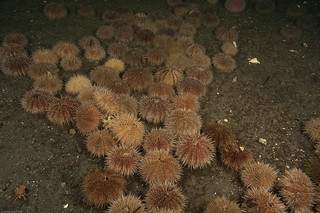
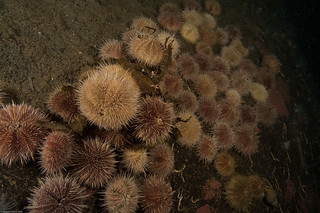
5 comments:
And then there's the CRAZY behavior of white urchins on barrens as documented by Coyer et al. 1987. That always blows me away.
D'OH! I KNEW I saw that somewhere! I was looking for that other predation paper last week. Now I gots it! thank you!
Friends just mentioned that a recently placed artificial reef, the USS Mohawk was entirely covered with urchins when they dived it in May. There were very few when they dived it in November. Those critters work fast!
This is cool!
Very nice unbelievable creatures in marine environment
Post a Comment